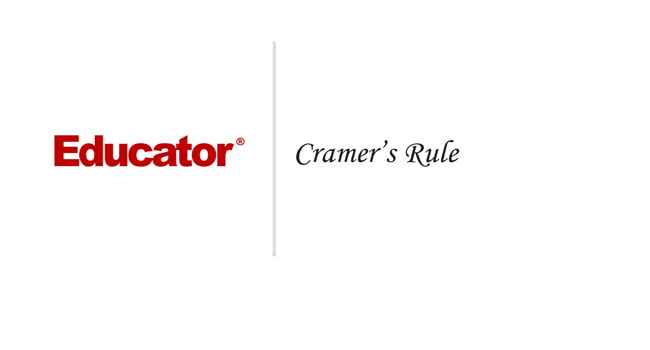Connecting...

This is a quick preview of the lesson. For full access, please Log In or Sign up.
For more information, please see full course syllabus of Algebra 2
For more information, please see full course syllabus of Algebra 2
Algebra 2 Cramer's Rule
Lecture Description
In this lecture, you'll learn how to apply determinants in order to solve systems of equations. The rule we're going to use is called Cramer's rule. Using Cramer's rule, we can solve systems of equations with both two variables and three variables by using only determinants. There is no graphing or algebraic work involved. The examples will help you understand this matter a little better. Cramer’s rule indicates situations in which a system does not have a unique solution. It does not specify whether the system has no solution or an infinite number of solutions
Bookmark & Share
Embed
Share this knowledge with your friends!
Copy & Paste this embed code into your website’s HTML
Please ensure that your website editor is in text mode when you paste the code.(In Wordpress, the mode button is on the top right corner.)
×
Since this lesson is not free, only the preview will appear on your website.
- - Allow users to view the embedded video in full-size.
Next Lecture
Previous Lecture









































 Carleen Eaton
Carleen Eaton Grant Fraser
Grant Fraser
 Answer Engine
Answer Engine



0 answers
Post by Jinjin Chai on February 21, 2021
I just checked the work for example 1 at 3:34 because I was confused - I noticed that the denominator for x was -9, and 4 was the value of x. I solved for Dr.Eaton's determinant and got -18/4, or -4.5. However, when I plugged in the value for x into the first equation, I got that y was 2, not -4.5. Furthermore, if the denominator was -9, which was what the denominator was for x, the solution for the determinant for y would've been 2, which is correct.
In short, Dr.Eaton made a small error for the first example at 3:34 - for any people confused. the answer is 2, and the equation for the determinant is
|3 2|
|-3 -8| -18
_______ = __________ = 2!
-9 -9
0 answers
Post by Qing Xu on March 20, 2020
THANKS SO MUCH! You can explain this to a person really well. I'm a 5th grader, and I understood
1 answer
Last reply by: Joshua Chen
Tue Jun 16, 2020 10:08 AM
Post by DJ Sai on September 10, 2018
Why are your outros different every time
1 answer
Sun Apr 8, 2018 2:48 PM
Post by John Stedge on March 29, 2018
Never mind you caught your mistake! Great job!
1 answer
Last reply by: DJ Sai
Mon Sep 10, 2018 11:30 PM
Post by John Stedge on March 29, 2018
At about 22:24 you miss-multiplied the last group of #'s (1*2*-2) and you put (-2) in the denominator instead of (-4) as it should be therefore the final answer is incorrect.
1 answer
Sat Oct 3, 2015 7:15 PM
Post by Peter Ke on September 30, 2015
For example 4, I used the expansion b minors, and I used (2, -3 . 1) for my denominator. And when I solved it I got 12 + 18 - 18 which wasn't equal to 0. What did I do wrong?
3 answers
Wed Jan 1, 2014 12:52 AM
Post by Rob Escalera on May 21, 2012
Yes, I think the determinant (D) should be -9, and x = 4 while y = 2.
4 answers
Last reply by: Miranda Winther
Tue Oct 29, 2013 9:19 PM
Post by aloosh aloosh on February 17, 2011
to solve for y isnt d=9 not 4
????
1 answer
Thu Feb 3, 2011 1:48 PM
Post by Santhini Dheenathayalan on February 1, 2011
Great video, Dr. Eaton! Thank you!